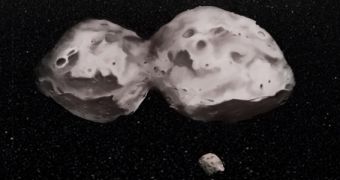A group of astronomers at the Search for Extraterrestrial Intelligence (SETI) Institute was recently able to establish, following an 8-year study, that the only known asteroid in our solar system to feature a moon flies around the Sun in a very peculiar, exotic orbit. The Trojan-class object is called (624) Hektor.
Thus far, it is the only known space rock in our solar system to feature a moon, and astronomers have been trying to figure out exactly how this was made possible. According to the new study, an ancient collision between two asteroids may have been responsible for this unusual situation.
The work also revealed that Hektor may in fact be a Kuiper Belt object that was thrown towards the inner parts of the solar system during a time when the gas and ice giants around the Sun shifted their orbits significantly before finally settling down. The Kuiper Belt is a collection of frozen space objects located towards the outer edges of the system, beyond the orbit of Pluto.
The new study was detailed in a paper published in the February 27 issue of the top scientific journal Astrophysical Journal Letters. The data used in this investigation was collected with the W. M. Keck Observatory in Hawaii and other telescopes around the world.
The image that appears to be emerging is one where Hektor was created following the collision of two frozen asteroids, back when the solar system was just a fraction of its current age. The asteroid's moon was first identified by SETI astronomer Franck Marchis in 2006.
The expert and his team used the 10-meter (33-foot) Keck II Telescope on Mauna Kea to observe the tiny orbiting mass. Observations were made possible through the use of the Near-Infrared Camera 2 (NIRC-2) instrument, in conjunction with the laser guide star and adaptive optics system (LGS-AO).
The new study also included experts from the University of California in Berkeley and the Institut de Mécanique Céleste et de Calcul des Éphémérides (IMCCE) at the Observatoire de Paris. Using new Keck data, the team found that the moon is 12 kilometers (7.8 miles) across.
The object spins around the 250-kilometer (155-mile) asteroid at a distance of around 600 kilometers (373 miles), once every three days. Its ellipse is exotic, the team says, as it is inclines to almost 45 degrees with respect to Hektor's equator.
“The orbit of the moon is elliptical and tilted relative to the spin of Hektor, which is very different from other asteroids with satellites seen in the main-belt,” explains study coauthor Matija Cuk, who is a research scientist with the Carl Sagan Center at the SETI Institute.
“However, we did computer simulations, which include Hektor being a spinning football shape asteroid and orbiting the Sun, and we found that the moon’s orbit is stable over billions of years,” the expert adds.

 14 DAY TRIAL //
14 DAY TRIAL //